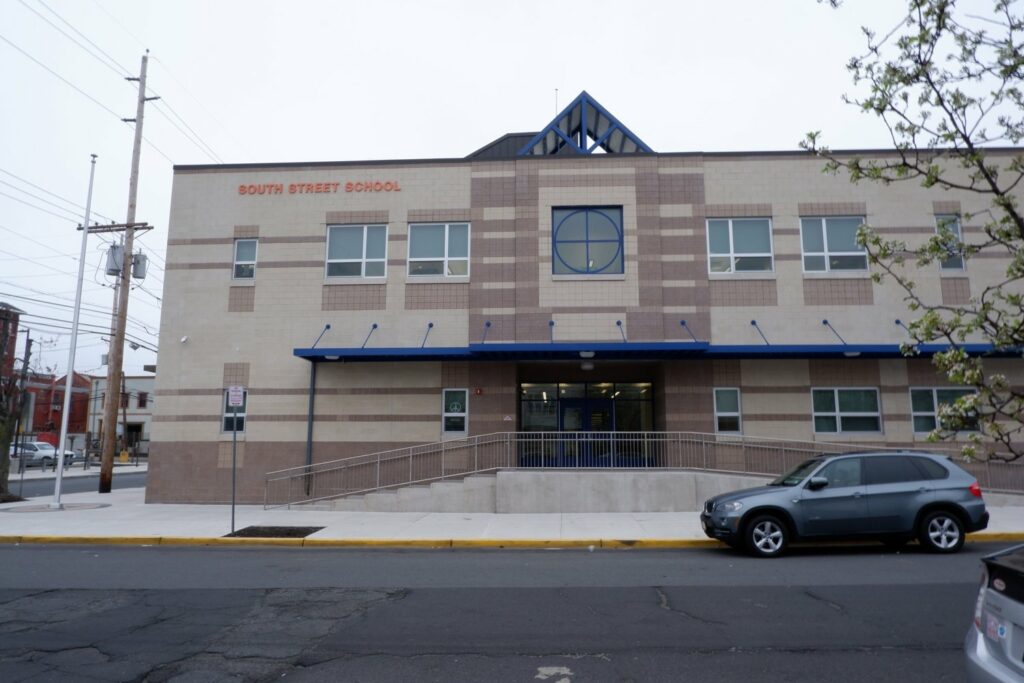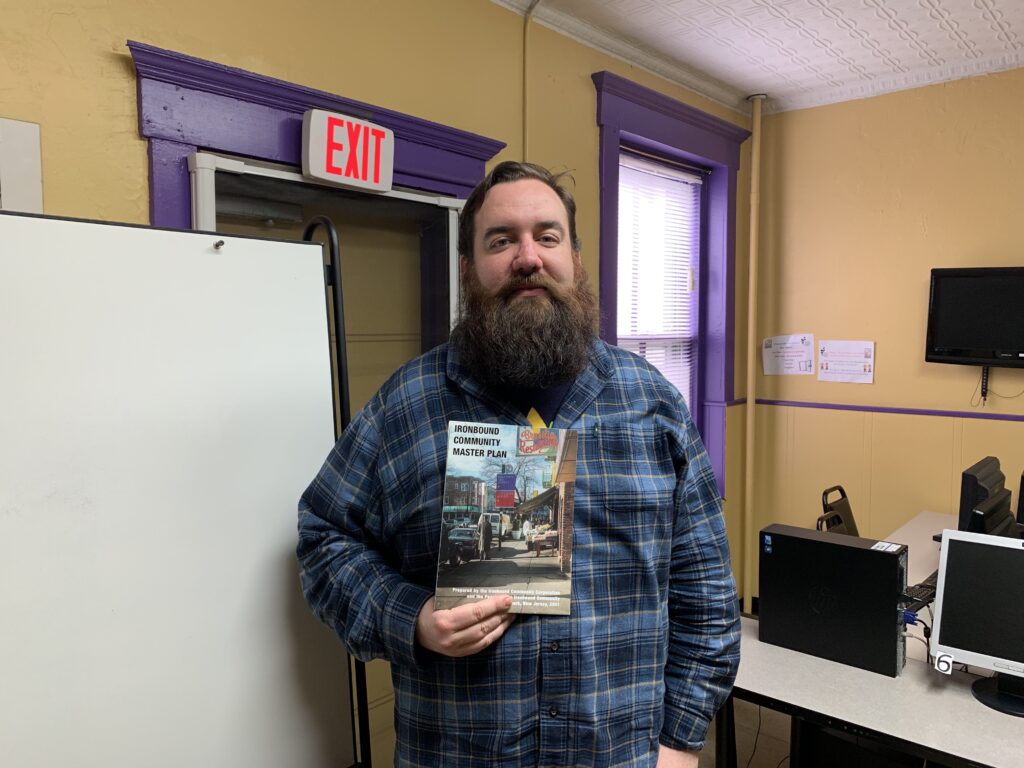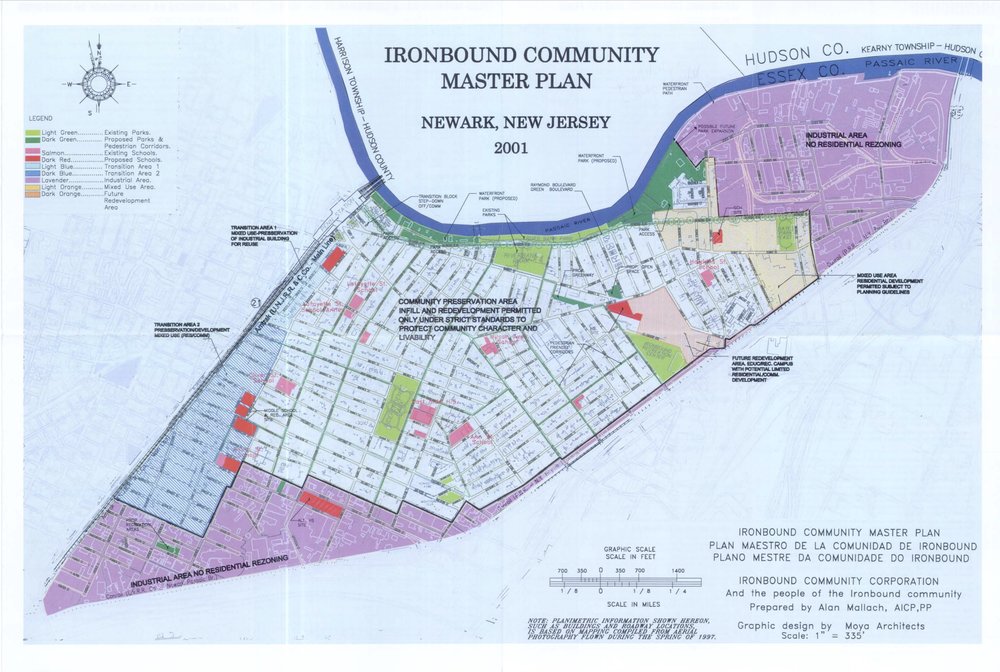The nature of these chemicals is they are that toxic. Clearly you’re not allowed to build on them. So you shouldn’t be living ten feet from them either.
MEDINILLA SOARES, IRONBOUND COMMUNITY MEMBER
An Environmental Justice Issue
The former factory, school, firehouse, and plots of land surrounding the family home of Medinilla Soares’ are among the 150+ active brownfield sites in Newark’s Ironbound. Under New Jersey state law, a brownfield site is defined as any former or current commercial or industrial site where there has been, or there is suspected to have been, a discharge of a contaminant.
Since the Industrial Revolution, the Ironbound has been comprised of a mixture of industrial, commercial, and residential uses, often right next to one another. With the presence of industry comes the reckless and dangerous disposal of hazardous chemicals. Whether it be by leak or intentional dumping, contaminants seep into the air, water, and soil of nearly every inch of the Ironbound. Leaving the community vulnerable to toxic substances through inhalation or ingestion.
629
ACTIVE CONTAMINATED SITES IN NEWARK
150+
BROWNFIELD SITES IN THE IRONBOUND
95%
OF RESIDENTS IN THE IRONBOUND LIVE CLOSER TO A HAZARDOUS WASTE SITE THAN THE REST OF THE U.S.
Bill Lindner, New Jersey Department of Environmental Protection
No Money, No Remediation
When there is no one left to hold accountable for the cleanup of a brownfield site, who is responsible? If the former company who occupied the land goes out of business or the original owners cannot be located, how do we get these contaminated plots of land remediated?
Unfortunately, when the party at fault is no longer accessible, the city or town automatically becomes responsible for brownfield sites. The land can either be sold to a private developer who then hires a Licensed Site Remediation Professional (LSRP) to oversee the project, or the city can apply to the New Jersey Department of Environmental Protection Site Remediation Program for a grant for public funds to cover the remediation costs.
The harsh reality of lower income communities like the Ironbound is that often times, these brownfield sites are left vacant for years. The percentage of individuals below the poverty level in the Ironbound is 28%, which is over three times the state average. The community does not have an excess of funds to avidly remediate every single one of the 150+ brownfield sites. Therefore, the community is left to bare the burden of these chemicals and other hazardous toxins.
28%
OF THE POPULATION IN THE IRONBOUND IS BELOW THE POVERTY LINE
< 50%
OF THE POPULATION IN THE IRONBOUND ARE IMMIGRANTS
Conversely, in economically advantageous times, private redevelopers often purchase brownfield sites and fund the remediation as an investment. A majority of the new properties being developed in the Ironbound are luxury residential units, which leads to gentrification rather than improving the lives of longstanding residents who can no longer afford rent.
CASE STUDY: The New South Street School
A school built on top of a remediated brownfield site

Built on top of a remediated brownfield site, The New South Street opened at the end of 2018. The plot of land was formerly owned by Ruggerio’s Seafood Company until 2004, who is being sued by the state to recoup pollution remediation costs at the site.
In late 2018, the Ironbound celebrated the opening of the new South Street School at 44 Herman Street. The South Street School can house 657 students, has advanced technology and state of the spaces to meet the needs of every student. This is a milestone for education in Newark because the community is in dire need of more schools… but there is a catch: The South Street School is built on top of a brownfield site.
The New Jersey Schools Development Authority v. Ruggiero Seafood lawsuit says that the New Jersey School Development Authority (SDA) anticipates that additional remediation will be required at the school, including operation and maintenance of the redemptional actions. In the meantime, students attend classes on the site.

In the 1980s, the property was bought by the largest calamari processing plant in the country, Ruggiero Seafood Co. It was later discovered that petroleum, volatile organic compounds, and other hazardous materials were discharged over time. Acetone, lead, and mercury were also found in the groundwater. In 2004, the New Jersey School Development Authority (SDA) wanted to purchase the property and Ruggiero agreed to take on responsibility for the remediation of the site. Ruggiero was too slow to complete the project and the SDA took over the clean up cost of $8.8 million dollars. The clean up included complete excavation and disposal of contaminated soil, as well as removal and treatment of 10.59 million gallons of groundwater. The SDA is now suing Ruggiero Seafood to recover the remediation costs.
Paul McAndrew, an associate at Langan Engineering and Environmental Services Inc., says it is not always feasible to removal all contaminants from brownfield sites. In places like Newark, it is particularly hard to remove all contamination from a site and deem it totally uncontaminated. Parts of Newark were filled in over the years. The NJDEP allows for remediates to you to cap it and contain contaminants. For a school, residence, or childcare center, the presumptive remedy is six inches of concrete over 18 inches of clean soil.
“There may be a vapor mitigation system underneath the school,” says McAndrew, who is unfamiliar with the particularities of the South Street School remediation effort. “Certain types of contaminants---volatile organic contaminants--- can create vapors underground that will travel through the pore space in the soil and get into buildings. Most buildings built today have a vapor barrier built underneath them. If they're built on a site that has volatile organic compounds, we'd use a thicker vapor barrier and then also include perforated piping and vent pipes coming up to the top of the building. So that any vapors that do get under the building have a way to get out to the atmosphere.”
McAndrew declined to let us release his full interview. When we contacted the Licensed Site Remediation Professional responsible for the South Street School remediation, no one answered. McAndrew believes that officials are more likely to avoid talking about the new South Street School and Ruggiero Seafood Co. because of the pending lawsuit.
The Community Fights Back

The Community Fights for Environmental Justice
According to “Remediating and Redeveloping Brownfields in New Jersey: A Guide for Municipalities and Organizations,” brownfields represent the opportunity for the citizens, government and nonprofit organizations to collaborate.

In the Ironbound, the Ironbound Community Corporation (ICC) works directly with the state and environmental nonprofit law groups to make sure remediation is done up to code and the facilities that are developed on top of these sites are beneficial to the community. In 2015, the ICC created the South Ironbound Resiliency Plan to inventory and prioritize brownfield sites, including assessment of the remediation needs and costs, according to the redevelopment priorities identified, and area-wide plans prepared, through public consultation (e.g., Brownfield’s Master Plan Element, Brownfield Area Wide Plan, or Redevelopment Plan).
Successful initiatives overseen by the ICC include Riverfront Park, Down Bottom Farms, the Ironbound Stadium, and the emergency clean-up of the Tidewater Bailing Site.
We’ve even heard stories of a mini cancer cluster around [the Murphy Varnishing Factory], so we don’t know too much about it but it’s definitely a significant public health concern in this area too.
DREW CURTIS, SENIOR EQUITABLE DEVELOPMENT MANAGER, IRONBOUND COMMUNITY CORPORATION
In addition, the ICC is working with a nonprofit environmental law group to access stories of mini cancer clusters in the Ironbound, particularly near the Murphy Varnish Factory and Manufacturer’s Place. The ICC is concerned that there is an association with environmental contamination and cancer clusters in the Ironbound. According to the “Task Force on Cancer Clusters In New Jersey by the The New Jersey Department of Health and Senior Services (NJDHSS), contaminants could travel from their source, through the environment, to enter the human body through air, water, food, or direct contact with the skin. The study also states that it is difficult to distinguish whether a cancer cluster is by chance or by “demographic, genetic, behavioral, environmental or healthcare system hazards.”
There is an ongoing state investigation with the Attorney General thanks to the ICC and supporting tenants at the residential units built on top of the former Ronson Butane lighter manufacturing site.
Citations
Office of Brownfield Reuse. NJDEP SRP - Brownfields, New Jersey Department of Environmental Protection, 11 July 2013, www.nj.gov/dep/srp/brownfields/.
“EPA's Environmental Justice Screening and Mapping Tool.” EJ SCREEN, Environmental Protection Agency, 2018, ejscreen.epa.gov/mapper/.
2018 American Community Survey, et al. American FactFinder, United States US Census Bureau, 5 Oct. 2010, factfinder.census.gov/faces/nav/jsf/pages/index.xhtml.
New Jersey Law Journal. “Condemnation Settlement of $5.15M | New Jersey School Construction Co. v. Ruggiero Seafood Co.” Carlin & Ward, P.C., 27 Dec. 2004, www.carlinward.com/CondemnationCondemnation-Settlement-of-5-15M-Settlement-of-5-15M.shtml.
NEW JERSEY SCHOOLS DEVELOPMENT AUTHORITY (corporate successor to New Jersey Schools Construction Corporation), Plaintiff, v. CHIQUITA BRANDS INTERNATIONAL, SÀRL; CHARTER MANUFACTURING COMPANY, INC.; RUGGIERO SEAFOOD, INC.; “ABC CORPORATIONS” 1 through 10 (Names Fictitious); and “JOHN DOES" 1 through 10 (Names Fictitious). https://uploads.thealternativepress.com/documents/5b621da9a947ca4e94005c3a/Ruggiero.pdf.
Ironbound Community Corporation, and American Planning Association New Jersey Chapter Community Planning Assistance Program. South Ironbound Resiliency Action Plan (Newark). 10 Sept. 2015, www.slideshare.net/APA-NJ/south-ironbound-resiliency-action-plan-newark.
New Jersey Department of Health and Senior Services . Task Force on Cancer Clusters In New Jersey . New Jersey Department of Health and Senior Services , Apr. 2004, www.nj.gov/health/ces/documents/TaskForceCancerClustersNJ2004.pdf.